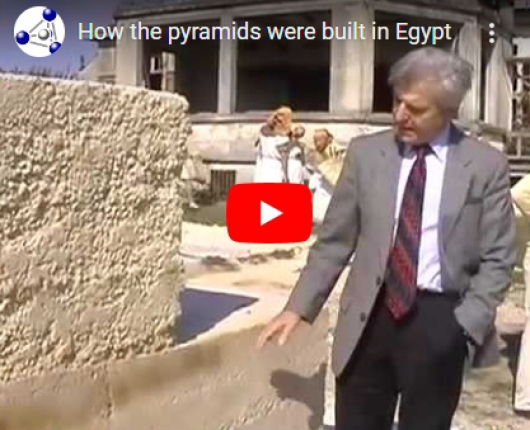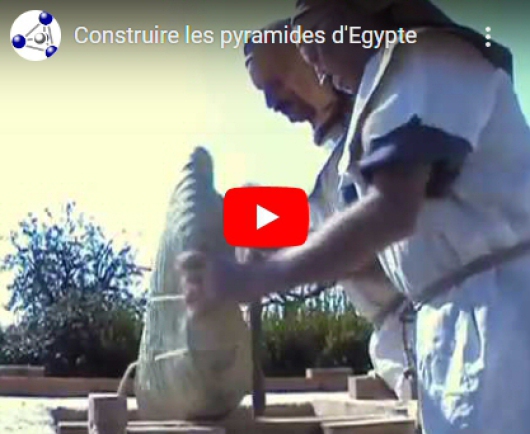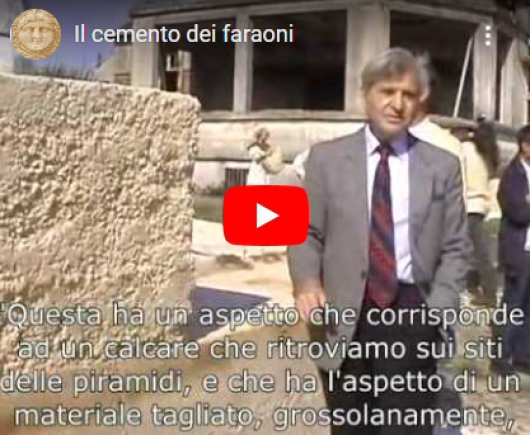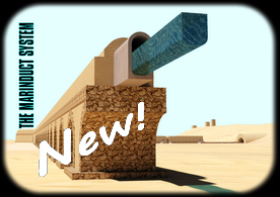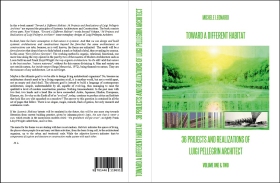The concrete
of Pharaohs
How the Great Pyramids were built in Egypt:
an enigma solved by Joseph Davidovits.
After its discovery will the Giza Pyramids be less mysterious?
No, one more time they testify to the greatness of Egyptian civilization. Perhaps we don't know all about their real function.
Aereal view on Google Maps of Giza Pyramids, Cairo, Egypt.
How the pyramids where built in Egypt
Building the Pyramids of Egypt with Artificial Stones
How to analyze pyramid stones
Tiwanaku / Pumapunku:
Megaliths are Artificial Geopolymers
BIBLIOGRAPHY
- Joseph Davidovits: "Why the pharaohs built the Pyramids with fake stones", Institute Géopolymère, Saint-Quintin, France, 2009.
In this book, Professor Joseph Davidovits explains the intriguing theory that made him famous. He shows how the Pyramids were built by using re-agglomerated stone (a natural limestone treated like a concrete), and not with huge carved blocks, hauled on fragile ramps. Archaeology bears him out, as well as hieroglyphic texts, scientific analysis, religious and historical facts. Several independant scientific studies reveal the ultimate proofs that the pyramids blocks are not natural. You may find various papers or opinions challenging the theory, but all prefer ignoring these analysis. Believing or not in the artificial stone theory is now simply irrelevant. It is a fact, a truth that is still fought by some people for irrational purposes. Here we finally have the first complete presentation on how and why the Egyptian pyramids were built. We discover its brilliant creator, the great scribe and architect, Imhotep. Joseph Davidovits sweeps aside the conventional image which cripples Egyptology and delivers a captivating and surprising view of Egyptian civilisation. He charts the rise of this technology, its apogee with the Pyramids at Giza, and the decline. Everything is logical and brilliant, everything fits into place. Chapter by chapter, the revelations are sensational, especially when Joseph Davidovits explains why the pharaohs stopped building great pyramids because of an over-exploitation of raw materials and a likely environmental disaster. We understand why Cheops and Ramses II represent two Egyptian civilisations completely different in their beliefs. On the one hand, the God Khnum mandates Cheops to build his pyramid in agglomerated stone, while on the other hand, the God Amun orders Ramses to carve stone for the temples of Luxor and Karnak. 30 years after the best seller book: The Pyramids: an enigma solved, after 30 years of new research, and new discoveries, you will understand why the theory is more alive than ever, why more and more scientists and archaeologists agree, simply because it is the truth.
- Joseph Davidovits and Margie Morris: "The Pyramids: An Enigma Solved by Joseph Davidovits ", Barnes & Noble Inc., N.Y.C., New York, U.S.A., 1991.
Construire les pyramides d'Egypte
La théorie du professeur Joseph Davidovits
sur la construction de la grande Pyramide
BIBLIOGRAPHIE
- Joseph Davidovits: "Bâtir les Pyramides sans pierres ni esclaves", Jean-Cyrille Godefroy, Paris, France, 2017.
- Joseph Davidovits: "Ils ont bâti les pyramides", Jean-Cyrille Godefroy, Paris, France, 2002.
Les grandes pyramides ont été bâties en pierre réagglomérée, c'est-à-dire une pierre calcaire naturelle fabriquée comme un béton. Telle est la théorie inédite qu'avance le professeur Joseph Davidovits, docteur ès sciences, membre de l'Association Internationale des Égyptologues. Dans la logique des importantes découvertes sur la chimie des minéraux dont il est à l'origine et après vingt-sept années de recherches, il fait dans ce livre la démonstration complète de son hypothèse et en apporte les preuves éclatantes. À la différence des autres théories de construction, celle-ci est la seule qui s'appuie sur des preuves archéologiques. Joseph Davidovits a en effet découvert les textes hiéroglyphiques décrivant la construction de ces gigantesques monuments ! Vous comprendrez alors que tous les problèmes et paradoxes liés à l'édification des pyramides sont résolus. Vous découvrirez qu'en Égypte, il y avait deux dieux de la création, opposés l'un à l'autre, prétextes à des conflits religieux et à des luttes de pouvoir menés pendant plus de mille ans. Le dieu Khnoum, vénéré par Khéops, est le dieu de la pétrification, de l'agglomération de la pierre pour les pyramides. 1 500 ans plus tard, le dieu Amon, vénéré par Ramsès II, impose la taille des pierres pour les temples et les obélisques. Pour ces deux grandes religions concurrentes, le travail de la pierre, réagglomérée ou taillée, était un acte sacré qui imitait la création de l'homme. Enfin, à la lumière de ces nouveaux faits, vous redécouvrirez l'histoire des grands personnages de cette période. Bien au-delà de la simple démonstration technique, le livre nous plonge dans l'histoire complexe d'une civilisation et de ses croyances pour en donner une nouvelle lecture surprenante et fascinante.
Il cemento dei faraoni
BIBLIOGRAFIA
- Joseph Davidovits: "Il calcestruzzo dei faraoni: così hanno costruito le grandi piramidi", Mondo Ignoto, Roma, 2004.
Libro, opera eccezionale scritta da un uomo, il Prof. Dott. Joseph Davidovits, già docente universitario dal 1983 al 1991 alla Barry University di Miami e alla Pennsylvania State University, USA, nonché dal 1979 docente e direttore dello "Institut Géopolymère" di Saint-Quentin in Francia, un centro di ricerca di livello internazionale (di riferimento per imprese, ricercatori, università di tutto il mondo, anche italiane) sui Geopolimeri - di sua originale definizione e invenzione -, un uomo che ha dato moltissimo all'umanità, con il suo immane lavoro di ricerca. Certamente Egli avrà dato pure moltissimo a sé stesso, in termini di onestà intellettuale e grande forza d'animo. Non solo un grande chimico, docente e divulgatore, ma anche un grande egittologo. Traduzione impeccabile dall'originale in francese. Il Prof. davidovits è affiancato dal figlio Frédéric Davidovits e altri validi ricecatori a Saint Quentin in Francia, con collaborazioni con tutto il mondo. M.L.
- Mario Pincherle: "La Grande Piramide e lo Zed", Macro Edizioni, Diegaro di Cesena, 2000.
Un libro meno "ortodosso" del precente del Prof. Davidovits, di stampo rigorosamente ed esaurientemente scientifico, senza per questo voler sminuire l'opera di un altro grande uomo, l'Ingegner Pincherle, che moltissimo ha dato al suo prossimo.
"Lo Zed" è tuttavia una scoperta originale dell'Ingegner Pincherle sulla Grande Piramide di Cheope. Quante cose che potremmo scoprire e sapere, ma il pregiudizio e il conformismo, nonché a volte grandi interessi di parte, ce lo impediscono. Questi sono grandi uomini: un Pincherle, un Davidovits, messaggeri di pace. Questo è vero progresso. M.L.





